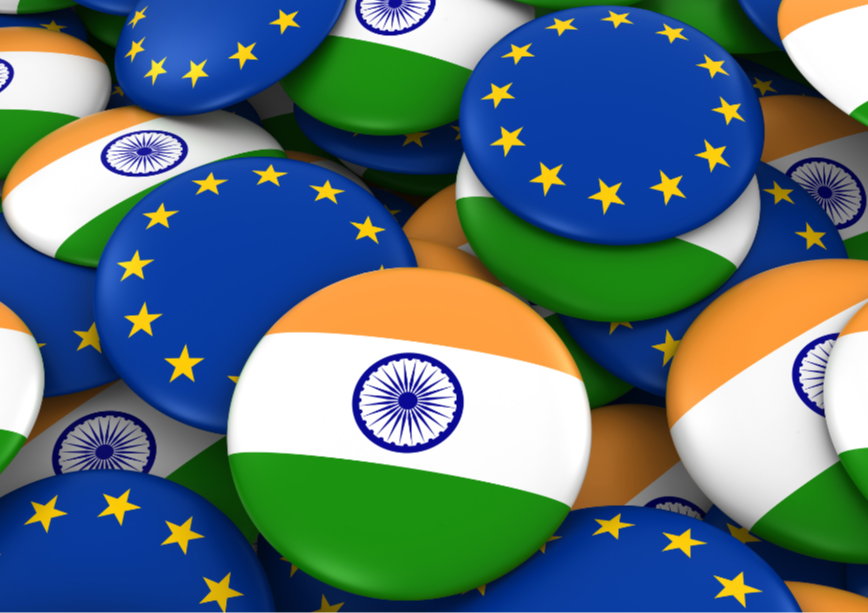
Background
In the ongoing EU-India Free Trade Agreement (FTA) negotiations, Geographical Indications (GIs) have emerged as a pivotal and contentious issue. GIs serve as an intellectual property protection for products that have a specific geographical origin and possess qualities, reputation, or characteristics inherent to that location. The contention arises over the extent of protection, enforcement mechanisms, and the impact on market access for non-GI products. Producers with a GI tag can name their products after the product’s geographic origin, while other producers are restricted from using that name for sales. For example, in the European Union, a sparkling wine is allowed to be named and marketed as “Champagne” only if it is produced in a defined geographical region of France by a process of double fermentation from grapes grown in the Champagne vine growing region. Even if a German manufacturer produces a sparkling wine that is technically similar, they can’t use the word “Champagne”.
Thus, GI usage allows for the localisation of economic benefits to a specific geography, by creating a unique market niche for products tied to a specific geographical origin, thus distinguishing them from goods produced elsewhere. This can provide an economic boost to the enterprises of that region.
GI usage allows for the localisation of economic benefits to a specific geography, by creating a unique market niche for products tied to a specific geographical origin, thus distinguishing them from goods produced elsewhere. This can provide an economic boost to the enterprises of that region.
Many GI-protected products are produced using traditional production methods that are tied to the cultural practices of the region. For Champagne, the authenticity of the product derives from the traditional winemaking practices of that region, which is crucial for maintaining its prestige and economic premium. The flow of greater economic value encourages the preservation of those traditional methods, which in turn contribute to increasing the economic value. Thus, the resultant economic benefits can also help preserve the cultural traditions of that geography.
GI tags in the EU–India FTA
The EU has been an advocate for stronger GI regulations across the world. The EU has been negotiating for greater recognition and protection of its GIs, not just with India, but also with China, Australia, and New Zealand. The EU does this because of the potential for GIs to boost their domestic industry. A European Commission report estimated that the sales value for the EU’s GI-protected agri and food products, to be about 75 billion euros in 2017. Wines accounted for 51 percent of this value, agricultural products and foodstuffs for 35 percent, spirit drinks for 13 percent and aromatised wine products for 0.1 percent. Notably, a fifth of the value was arising from exports.
Figure 1: Champagne GI recognition across the world
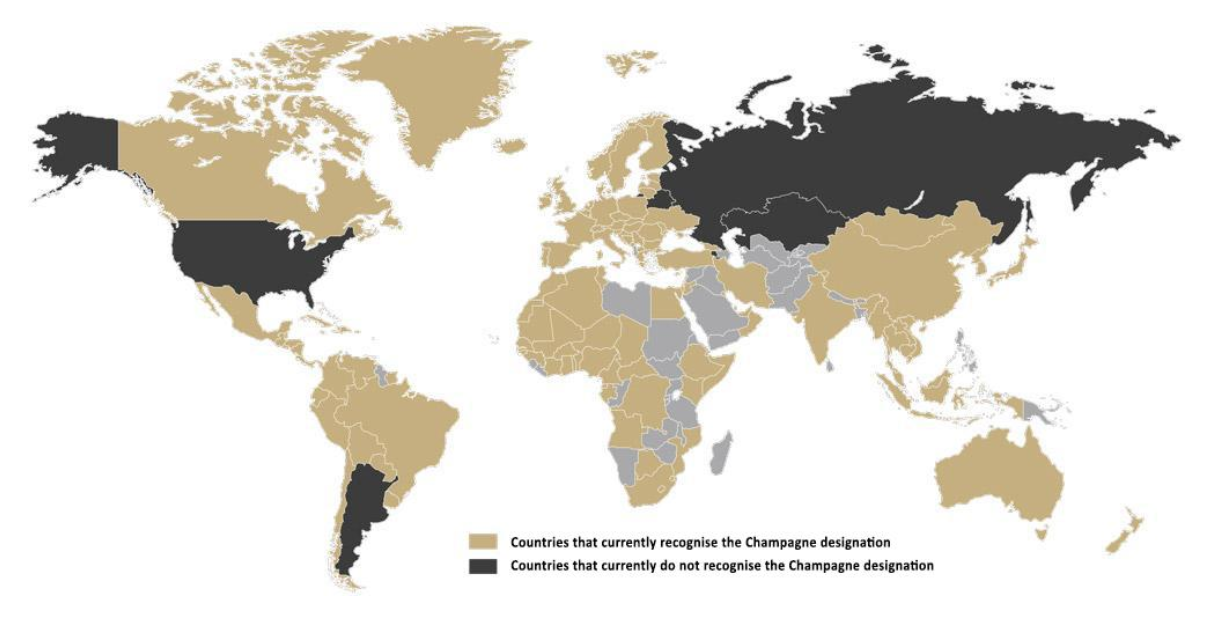
Source: Comité Champagne
Accepting EU regulations around GI tags would mean recognising EU GI tags in India and a reciprocal recognition of Indian GI tags in the EU. While the competitive potential of some Indian producers competing with European producers would be restricted, it would also open up the European market for those producers in India with GI tags. Considering that the EU is a market that values GI tags, it can represent a good export opportunity for India. Products with GI tags were also found to command a significant premium in the EU, with their sales value being double that of similar products without GI certification. However, for Indian firms to exploit this opportunity, much work needs to be done.
Products with GI tags were also found to command a significant premium in the EU, with their sales value being double that of similar products without GI certification.
India’s opportunity and challenges
The fact that GI tags could be useful for promoting economic interests has been recognised globally. Out of the estimated 58,400 protected GIs in existence in 2022, upper-middle-income and high-income economies accounted for almost 90 percent of the world total, with China and France accounting for 9,000+ GI tags and 5500+ respectively. China’s output value from GI producers was estimated at 82 billion euros in 2020.
Sadly, GI tags are severely underutilised in India. India has registered approximately 550 GI tags in total, which is far too low for India. Agricultural products accounted for less than 190 of these, while handicrafts made up more than half (281). This is in contrast to the world average, where wines accounted for half of the GI tags while other agricultural and food products made up another 43 percent—statistics which presumably reflect the economic potential of those categories.
Figure 2: GI tags in India
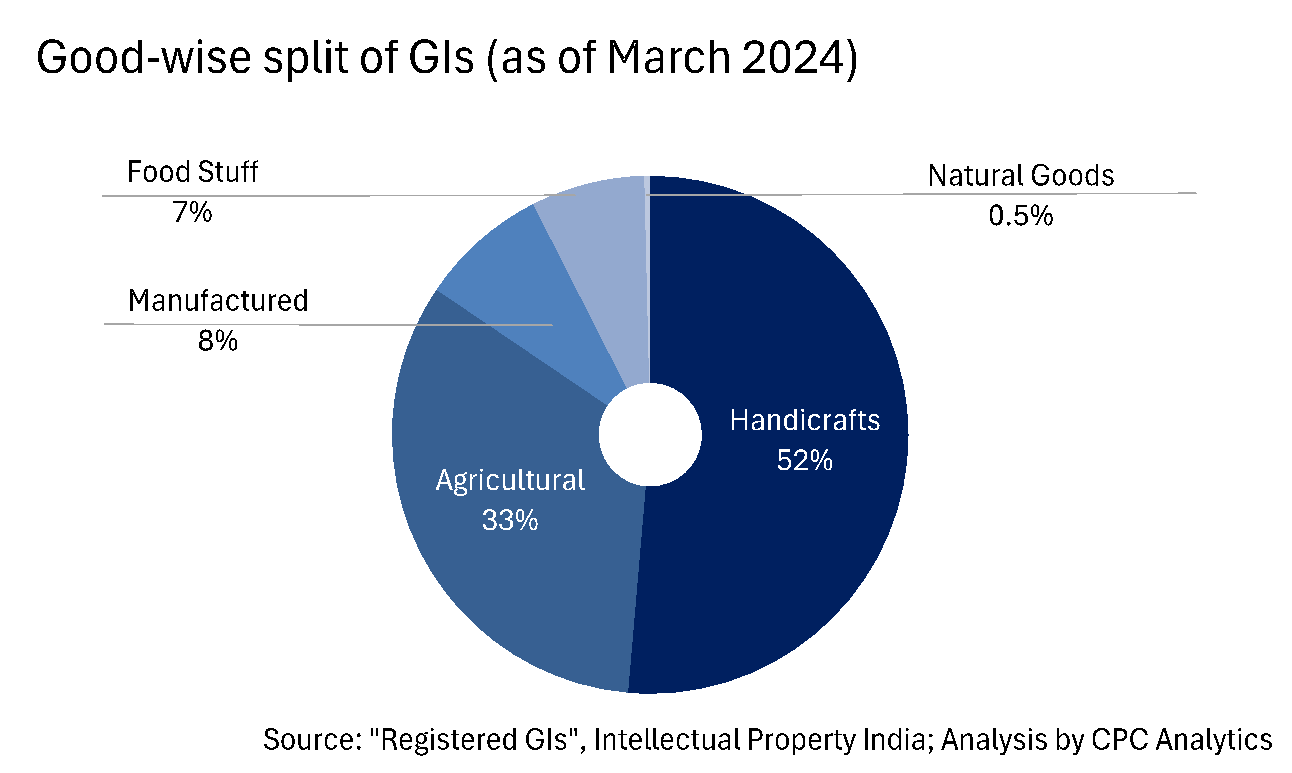
Source: "Registered GIs", Intellectual Property India; Analysis by CPC Analytics
Figure 3: Product-category wise GI tags globally (2022)
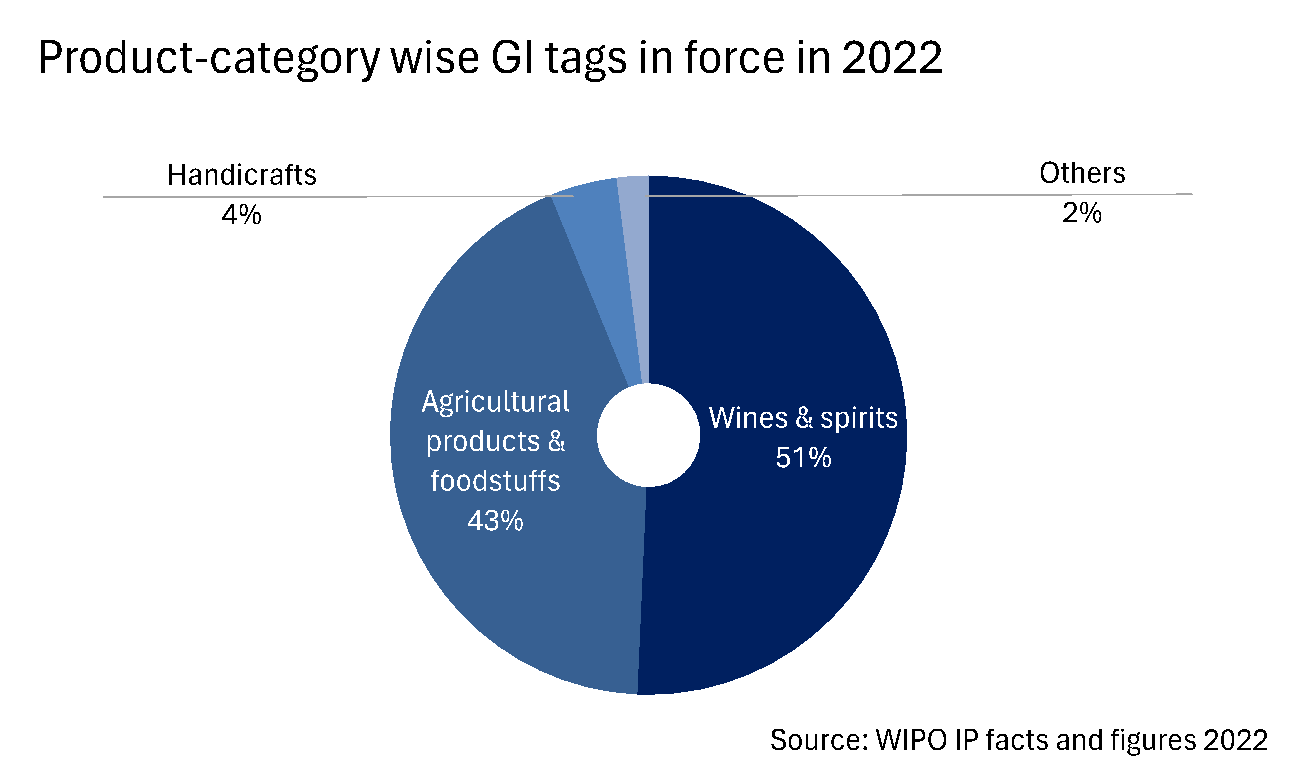
Source: WIPO IP facts and figures 2022
A second problem is the poor utilisation of the registered GI-tags. Awareness around GI tags is quite poor, leading to a situation where most agricultural goods with GI-tags in India don't even have a single registered user! Out of 181 GI-tagged agricultural goods, more than half (96) don’t have a single registered user. Many GI tags like the Madurai Malli, Joha Rice of Assam, and the Sirsi Supari have just one registered user.
Figure 4: Registered users for GI tags in India
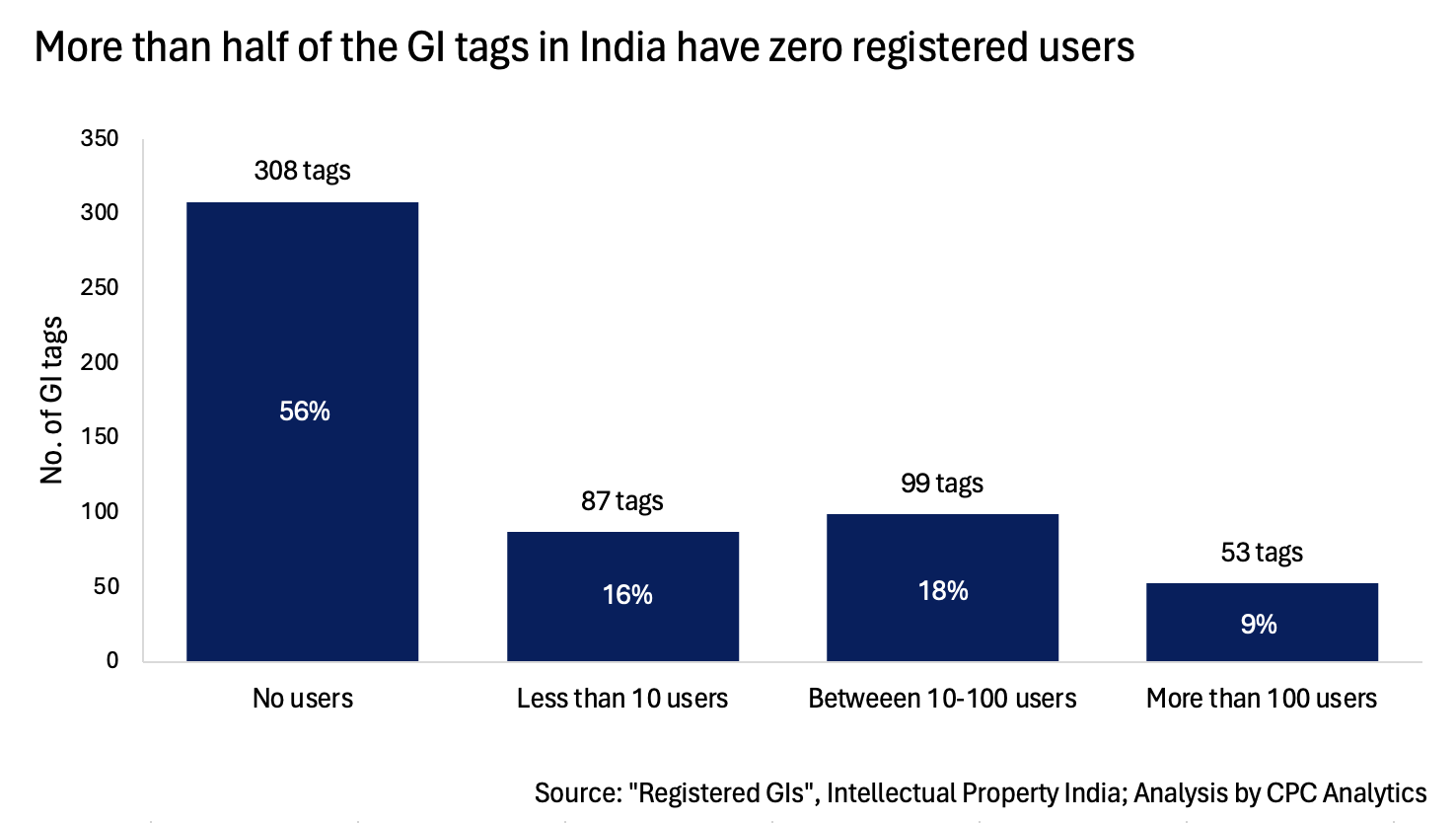
Source: "Registered GIs", Intellectual Property India; Analysis by CPC Analytics
Using GIs requires a high level of organisation and collective action from producers. Producers should register as users of the GIs, and also agree upon the minimum quality standards to be enforced for using the brand. Protecting the production process is critical for GIs, else, they risk losing the distinctiveness which has created the GI protected status. Resources need to be allocated for marketing of the common brand, and to enforce guidelines on using the common GI-tag on their goods. Further, monitoring the market for infringements, maintaining documentation, and vigorously defending against infringement are all actions that are required to maintain the brand effectiveness.
Resources need to be allocated for marketing of the common brand, and to enforce guidelines on using the common GI-tag on their goods.
The poor organisation of the Indian farming community makes it tough to take action. However, integrating GIs within existing initiatives like ‘Formation and Promotion of 10K Farmer Producer Organizations’. Through this initiative, small, and marginal farmers in the same geography, are organised for better productivity, lower costs, and higher profitability. Considering that GIs are geography-dependent, it would be ideal to use these FPOs to drive higher awareness around GIs. Effective utilisation of GIs would enable them to command a price premium for their produce, while protecting their traditional methods of production. Further, it would be important to offer state support to export-capable FPOs, especially for the for the technical skills and investment needed to meet EU legislations on food products.
Conclusion
GIs have been used internationally to boost economic outcomes. The EU-India FTA can open up the European market for India, but to use GIs effectively, much work needs to happen domestically. Organising the relevant communities, fostering collective action, helping them define and control production standards, and aiding their branding investments, can help create economic growth while retaining local cultural distinctiveness.
Omkar Sathe is a partner at CPC Analytics
The author would like to acknowledge the research inputs by Ovee Karwa.
The views expressed above belong to the author(s). ORF research and analyses now available on Telegram! Click here to access our curated content — blogs, longforms and interviews.




 PREV
PREV


